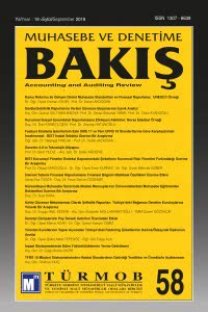RİSK ODAKLI İÇ DENETİM: TÜRKİYE’NİN 500 BÜYÜK SANAYİ İŞLETMESİNDE AMPİRİK BİR DEĞERLENDİRME
Yönetim anlayışındaki değişmeler, küreselleşme, teknolojik gelişmeler, yasal düzenlemeler ve diğer faktörlerşirketler için yeni fırsatlar ortaya çıkarmaktadır. Fakat bu fırsatlar önemli riskleri de beraberinde getirmektedir.Yaşanan gelişmeler nedeniyle işletmelerin güç duruma düşmeleri, denetim sisteminin etkinliği sorusunu ve Riskodaklı iç denetim sistemini gündeme getirmiştir.Risk odaklı iç denetim, risk yönetimi ve kurumsal yönetim anlayışının ayrılmaz bir parçası durumundadır. Riskodaklı iç denetime uygulama sürecinde uygun bir risk yönetim bölümünün kurulması ve risklerin yönetilmesi veçeşitli yaklaşımlarla risk yönetimi ve kurumsal yönetim uygulamasına daha fazla katkıda bulunma gibi önemligörevler düşmektedir. Bu bağlamda iç denetim bölümü gelecekte bilgi teknolojilerine hâkim olmanın yanındarisk ve değerlemesi konusunda uzman olmak durumundadır. Çalışmamızda geleneksel denetim ile risk odaklı içdenetim karşılaştırılmış, risk odaklı iç denetim süreci tanıtılmış ve Türkiye’nin 500 büyük sanayi işletmesinderisk odaklı iç denetim uygulama analizi yapılmıştır
Anahtar Kelimeler:
İç Denetim, Risk Odaklı İç denetim, Kurumsal Yönetim
The fluxes in the management concepts, globalization, technological developments, legal arrangements and theother factors create new facilities for the enterprises. However, these new facilities bring about important risksas well. The enterprises’ being in a difficult situation due to the latest improvements has brought up the question of the efficiency of the auditing system and the risk-based internal auditing systems.The risk-based internal auditing is the inseparable integral part of the risk management and the corporate governance. In the process of the implementation, the risk-based internal auditing has important functions such as theestablishment of an eligible risk management department and the management of the risks, and further supplements to the implementation of the risk and corporate governance with various methods. Thus, internal auditingdepartment must specialized risk and information systems management. In our study, traditional auditing andrisk based internal auditing have been compared, risk based internal auditing process has been described andemprical analysis of risk based internal auditing has been carried out in the five hundred industrial companiesof Turkey
___
- A.,A.,Rezaee, R. Elam Sharbatoghlie ve P. L. McMickle, Building Automed Auditing Capability, Auditing: A jo- urnal of Practice&Theory, March -2002.
- AlexInformation, Risk Based Auditing ,Alexbanking, Las cimas, Suite 300, Ausitin,2005.
- Basel Komitesi, Bankalarda İç Denetim ve Bankacılık Gözetim Otoritesinin İç ve Dış Denetçilerle ilişkisi, TBB, Temmuz 2000.
- Chambers A., The Operational Auditing Handbook: Auditing Business Processes,John Wiley and Sons, 1997.
- Committee of Sponsoring Organization of the Tradeway Commission (COSO), “Internal Control-Integrated Framework”, Jersey City, AICPA/COSO
- D. L. Searcy ve J.B. Woodroof, Continious Auditing: Leveraging Technology, The CPA Journal, May-2002 http://www.nysscpa.org/cpajournal/2003/05/03/dept/d054603.htm
- David Mcnamee ve George Selim, Changing Paradigm, Mc2 Managemenet Consulting, 1998, http://www.mc2consulting.com/riskart8.htm
- Flesher D.L. Operational Auditing, Journal of Accountancy, 1980.
- Gallaway Duncan, J. “Control Models in Perspective” Internal Auditor, 1994
- John Thompson, Lawrie Savage, “Risk Based Insurance Supervision The Canadian Approach” LOMA FLMI Conference, 2001.
- Jr., J. D. Warren, “Information Technology and CPAS: Where Are We Going?”, Today’s CPA, Semtember/ Oc- tober-1997.
- M.G.Alles, A.Kogan ve M. Vasarhelyi, Feasibility and Economics, Working paper, Rutgers University, Newark, NJ, 2001.
- M.Vasarhelyi, M.G. Alles ve A.Kogan, Principles of Analytic Monitoring for Continuous Assurance, Working paper, Rutgers University, Newark, NJ, 2003.
- M.Vasarhelyi, Researching Accounting as an Information Systems Discipline, The Institute of Internal Auditors Research Foundation, Altamonte Springs, FL, 2002.
- Mehmet Tahir Özsoy, Activeline Dergisi, “Risk odaklı iç denetim, ABD uygulaması ve Türkiye açısından de- ğerlendirilmesi”, Mart-Nisan 2004.
- Phill Griffiths, Risk Based Auditin, Gower Publishing Limited, 2005.
- Reider H.R., The Complete Guide to Operational Auditing, New York: John Wiley and Sons, 1994.
- Roth J. P. COSO Implementation Guide, Altamonte Springs, IIARF, 1995.
- Sainty Philip, İç Denetim Dergisi, “Kırılma Noktası/Risk Bazlı Denetime Doğru Atılan Adım”, Çev:Leyla Erkutoğ- lu, Sonbahar 2002.
- Sawyer L. B., Sawyer’s Internal Auditing, 4th Editon, Altamonte, IIA, 1996.
- Selim G. M. and Mcnamee D., Risk Management: Changing the Internal Auditor’s Paradigm, Altamonte, II- ARF, 1998.
- Smith J. E., An Evaluation of Selected Current Internal Auditing Terms, in Research Report, IIA, 1975.
- Tamsir Samsun, Risk Based Auditing: The Way Forward, The F1 Auditor, August-September 2002.
- The Institute of Internal Auditors, “Professional Practice Framework (The Standards for the Professional Practi- ce of Internal Auditing), 2002.
- Thomas E.Bayer, Risk Based Auditing: A New Approach, CFMA Building Profits, September/October 1999.
- Wallance Wanda A.G.&White T., Management Reporting on Internal Control, Altamonte Springs, IIARF, 1994.
- P. Jackson ve V. Livick – Chan, Control vs. Controls, http://www.camagazine.com/index.cfm/ci_id/ /1a_id/1/camagazine/1/print/true.htm www.bumko.gov.tr http://www.theiia.org
- ISSN: 1307-6639
- Yayın Aralığı: Yılda 3 Sayı
- Başlangıç: 2000
- Yayıncı: TÜRMOB
Sayıdaki Diğer Makaleler
Fehmi KARASİOĞLU, Adnan AKGÜL, Alper Veli ÇAM
ÇALIŞAN MORALİ VE İŞTEN AYRILMA İSTEĞİ: MUHASEBECİLİK MESLEĞİ ÜZERİNE BİR ARAŞTIRMA
Ali Ender ALTUNOĞLU, Başak ÇATALOĞLU, Algın OKURSOY
Şakir SAKARYA, H İbrahim ÖZMEN
KALİTE MALİYETLERİ VE YAŞAM BOYU MALİYETLEME YÖNTEMİ
Ercan BAYAZITLI, Yusuf KADERLİ, Eymen GÜREL
RİSK ODAKLI İÇ DENETİM: TÜRKİYE’NİN 500 BÜYÜK SANAYİ İŞLETMESİNDE AMPİRİK BİR DEĞERLENDİRME
Hüseyin ERGİN, Tansel ÇETİNOĞLU, Niyazi KURNAZ
YÖNETİM MUHASEBESİNDEKİ DEĞİŞİM VE DEĞİŞİMİ ETKİLEYEN FAKTÖRLER
